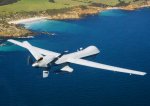Дмитрий Шаповалов (Velocity)
Хвост в самолете лишняя деталь!
- Откуда
- Москва
MQ-9 Reaper / Predator B
MULTI-ROLE PREDATOR--MQ-1/MQ-9
The MQ-9 Reaper is a medium-to-high altitude, long endurance remotely piloted aircraft system. The MQ-9's primary mission is as a persistent hunter-killer against emerging targets in support of joint force commander objectives. The MQ-9's secondary mission is to act as an intelligence, surveillance and reconnaissance asset, employing sensors to provide real-time data to commanders and intelligence specialists at all levels.
Features
The MQ-9 Reaper is the Air Force's first hunter-killer UAV. It is larger and more powerful than the MQ-1 Predator. Predator MQ-9 will deliver significantly expanded capabilities, flying twice as high, twice as fast, and carrying four times the weapons. Those include the GBU-12, EGBU-12, and GBU-38 500 lb. joint direct attack munition. The MQ-9 is designed to haul over 3,000 pounds of external ordnance to include the GBU-12, GBU-38, AIM-9 missiles and small diameter bombs. The MQ-9 will provide a hunter-killer capability and will feature the ability to use synthetic aperture radar to hunt for targets. It will be able to cross-cue targeting data to the electro-optic/infrared sensor.
The Reaper is designed to go after time-sensitive targets with persistence and precision, and destroy or disable those targets with 500-pound bombs and Hellfire missiles. The Reaper represents a significant evolution in UAV technology and employment. The Air Force moved from using UAVs primarily in intelligence, surveillance and reconnaissance roles before Operation Iraqi Freedom, to a true hunter-killer role with the Reaper.
The key advantage is not so much keeping manned aircraft and pilots out of harm's way, but the persistence UAVs can inherently provide. The Reaper can stay airborne for up to 14 hours fully loaded. A 900-horsepower turbo-prop engine, compared to the 119-horsepower Predator engine, powers the aircraft. It has a 64-foot wingspan and carries more than 15 times the ordnance of the Predator, flying almost three times the Predator's cruise speed.
The typical system consists of several air vehicles, a ground control station, communication equipment/links, spares and personnel who can be a mix of active duty and contractor personnel. The crew for the MQ-9 is a pilot and a sensor operator, who operate the aircraft from a remotely located GCS. To meet combatant commanders' requirements, the MQ-9 delivers tailored capabilities using mission kits that may contain various weapons and sensor payload combinations.
The MQ-9 baseline system has a robust sensor suite for targeting. Imagery is provided by an infrared sensor, a color/monochrome daylight TV and an image-intensified TV. The video from each of the imaging sensors can be viewed as separate video streams or fused with the IR sensor video. The laser rangefinder/designator provides the capability to precisely designate targets for laser-guided munitions. Synthetic aperture radar will enable Joint Direct Attack Munitions targeting. The aircraft is also equipped with a color nose camera, generally used by the pilot for flight control.
Each MQ-9 aircraft can be disassembled into main components and loaded into a container for air deployment worldwide in Air Force airlift assets such as the C-130. The MQ-9 air vehicle operates from standard U.S. airfields. The MQ-9 is based at Creech Air Force Base, Nev.
MULTI-ROLE PREDATOR--MQ-1/MQ-9
The MQ-9 Reaper is a medium-to-high altitude, long endurance remotely piloted aircraft system. The MQ-9's primary mission is as a persistent hunter-killer against emerging targets in support of joint force commander objectives. The MQ-9's secondary mission is to act as an intelligence, surveillance and reconnaissance asset, employing sensors to provide real-time data to commanders and intelligence specialists at all levels.
Features
The MQ-9 Reaper is the Air Force's first hunter-killer UAV. It is larger and more powerful than the MQ-1 Predator. Predator MQ-9 will deliver significantly expanded capabilities, flying twice as high, twice as fast, and carrying four times the weapons. Those include the GBU-12, EGBU-12, and GBU-38 500 lb. joint direct attack munition. The MQ-9 is designed to haul over 3,000 pounds of external ordnance to include the GBU-12, GBU-38, AIM-9 missiles and small diameter bombs. The MQ-9 will provide a hunter-killer capability and will feature the ability to use synthetic aperture radar to hunt for targets. It will be able to cross-cue targeting data to the electro-optic/infrared sensor.
The Reaper is designed to go after time-sensitive targets with persistence and precision, and destroy or disable those targets with 500-pound bombs and Hellfire missiles. The Reaper represents a significant evolution in UAV technology and employment. The Air Force moved from using UAVs primarily in intelligence, surveillance and reconnaissance roles before Operation Iraqi Freedom, to a true hunter-killer role with the Reaper.
The key advantage is not so much keeping manned aircraft and pilots out of harm's way, but the persistence UAVs can inherently provide. The Reaper can stay airborne for up to 14 hours fully loaded. A 900-horsepower turbo-prop engine, compared to the 119-horsepower Predator engine, powers the aircraft. It has a 64-foot wingspan and carries more than 15 times the ordnance of the Predator, flying almost three times the Predator's cruise speed.
The typical system consists of several air vehicles, a ground control station, communication equipment/links, spares and personnel who can be a mix of active duty and contractor personnel. The crew for the MQ-9 is a pilot and a sensor operator, who operate the aircraft from a remotely located GCS. To meet combatant commanders' requirements, the MQ-9 delivers tailored capabilities using mission kits that may contain various weapons and sensor payload combinations.
The MQ-9 baseline system has a robust sensor suite for targeting. Imagery is provided by an infrared sensor, a color/monochrome daylight TV and an image-intensified TV. The video from each of the imaging sensors can be viewed as separate video streams or fused with the IR sensor video. The laser rangefinder/designator provides the capability to precisely designate targets for laser-guided munitions. Synthetic aperture radar will enable Joint Direct Attack Munitions targeting. The aircraft is also equipped with a color nose camera, generally used by the pilot for flight control.
Each MQ-9 aircraft can be disassembled into main components and loaded into a container for air deployment worldwide in Air Force airlift assets such as the C-130. The MQ-9 air vehicle operates from standard U.S. airfields. The MQ-9 is based at Creech Air Force Base, Nev.


